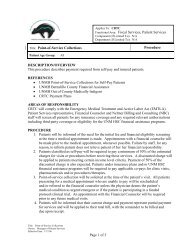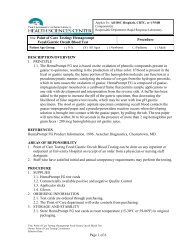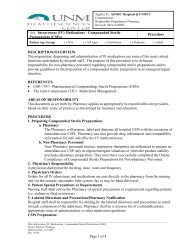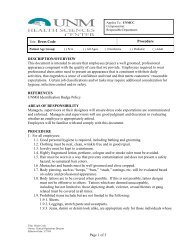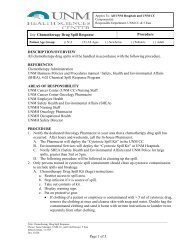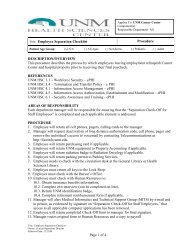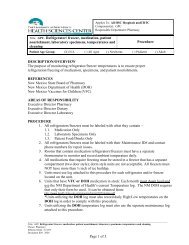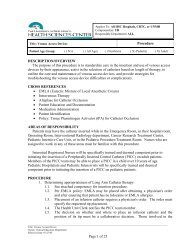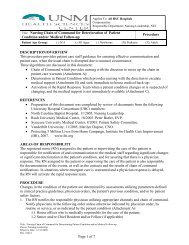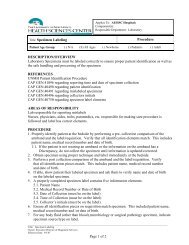Page 1 of 4 DESCRIPTION/OVERVIEW Intravenous (IV) therapy will ...
Page 1 of 4 DESCRIPTION/OVERVIEW Intravenous (IV) therapy will ...
Page 1 of 4 DESCRIPTION/OVERVIEW Intravenous (IV) therapy will ...
Create successful ePaper yourself
Turn your PDF publications into a flip-book with our unique Google optimized e-Paper software.
Title: <strong>Intravenous</strong> Therapy<strong>DESCRIPTION</strong>/<strong>OVERVIEW</strong><strong>Intravenous</strong> (<strong>IV</strong>) <strong>therapy</strong> <strong>will</strong> be administered and monitored utilizing established guidelines.REFERENCES Perry, E.M., & Potter, P. (2010). Clinical Nursing Skills & Techniques (7 th ed.). St. Louis,Missouri: Mosby - Elsevier CDC “Guidelines for Prevention <strong>of</strong> Intravascular Catheter-Related Infections”, August 9,2002/51(RR10); 1-26 Infusion Nurses Society. Infusion Nursing Standards <strong>of</strong> Practice. Journal <strong>of</strong> Infusion Nursing(supplement) 2006. Wiegand D, Carlson K: AACN Procedure Manual for Critical Care, Elsevier Inc, 2005AREAS OF RESPONSIBILITYAll Nursing UnitsApplies To: All HSC HospitalsResponsible Department: All Nursing UnitsRevised: 6/2010GuidelinePatient Age Group: ( ) N/A (X) All Ages ( ) Newborns ( ) Pediatric ( ) AdultGUIDELINE PROCEDURE1. Registered Nurses (RN), Graduated Nurses (GN), and Licensed Practical Nurses II (LPN II)who have demonstrated competence, may start and discontinue peripheral <strong>IV</strong>s. Nurse Interns andStudent Nurses (SN) under the direct supervision <strong>of</strong> an RN may also start and discontinueperipheral <strong>IV</strong>’s.1.1 Other non-nursing medical personnel who have demonstrated competence in <strong>IV</strong><strong>therapy</strong>, and have <strong>IV</strong> <strong>therapy</strong> as part <strong>of</strong> their scope <strong>of</strong> practice, maystart/discontinue and administer <strong>IV</strong> <strong>therapy</strong>.1.2 Only RNs, supervised GNs, Interns, and SNs and other non-nursing medicalpersonnel may give <strong>IV</strong> push medications based on unit policy and scope <strong>of</strong>practice. After successful completion <strong>of</strong> the <strong>IV</strong> Therapy module, and appropriatedocumentation <strong>of</strong> competence, LPNs may also give <strong>IV</strong> push medications2. Initiation <strong>of</strong> venipuncture should be limited to two (2) attempts per person. Considercontacting Rapid Response Team to use their doppler to start a difficult <strong>IV</strong>. Carefulconsideration should be given to other venous access modalities if peripheral <strong>IV</strong> access is notobtained after a limited number <strong>of</strong> attempts. Patients who potentially require long-term <strong>IV</strong><strong>therapy</strong> should be assessed for long-term catheter placement.3. Selecting <strong>IV</strong> site and catheter3.1 In the adult population, a Licensed Independent Provider’s (LIP) order is neededto place an <strong>IV</strong> in the lower extremities. The <strong>IV</strong> should be transferred to an upperextremity or central line as soon as possible.3.2 An <strong>IV</strong> <strong>will</strong> not be started in a patient’s arm in which a functional arterio-venous(AV) shunt exists, or on the surgical side <strong>of</strong> a post mastectomy patient, or into thesame arm which has an existing PICC.3.3 Any <strong>IV</strong> initiated pre-hospital should be restarted within 24 hours <strong>of</strong> admission._________________________________________________________________________________________________________________Title: <strong>Intravenous</strong> TherapyOwner: Nursing Practice CouncilEffective Date: 7/7/2010Doc. # 2636<strong>Page</strong> 1 <strong>of</strong> 4
3.4 Two large bore <strong>IV</strong>s <strong>of</strong> at least 18 gauge diameter in large veins are required forany emergency situation where large volumes <strong>of</strong> fluid and <strong>IV</strong> medicationsmight be required. The antecubital site is preferred. When the patient’s conditionis stabilized, the site should be changed if possible to a site not overlying a jointwith a smaller diameter catheter.3.5 If caustic agents are ordered or anticipated, a central line or a site on the proximalforearm is preferred. Do not choose a site over a joint if at all possible and avoidthe medial antecubital vein unless no other site is available. Caustic substancesshould not be infused through an <strong>IV</strong> located in the lower extremity. Consultpharmacy for a current list <strong>of</strong> caustic agents.3.6 In a cardiopulmonary emergency, vasoactive medications (including Dobutamine,Dopamine, Norepinephrine, Epinephrine and Esmolol) may be administeredperipherally, but central access should be established as soon as possible.4. Routine Care4.1 Standard precautions <strong>will</strong> be used when performing all aspects <strong>of</strong> <strong>IV</strong> <strong>therapy</strong>.Aseptic technique <strong>will</strong> be used for all venipunctures and dressing changes.4.2 Dressing changes should be done whenever the dressing becomes damp,loosened, soiled, or as needed.4.3 All patients on <strong>IV</strong> <strong>therapy</strong> should be monitored for intake and output (I&O).4.4 All <strong>IV</strong> bottles/bags should be changed at least every 24 hours. All cassettes andtubing should be changed every 72 hours, with the following exceptions:4.4.1 Intralipid, Total Parenteral Nutrition (TPN), Peripheral ParenteralNutrition (PPN), dextrose solution 10%, and tubing <strong>of</strong> thesesolutions must be changed every 24 hours. TPN and PPN filters<strong>will</strong> be replaced with tubing change.4.4.2 Pressure line tubing (arterial, central venous pressure, pulmonaryartery catheter)and flush solution should be changed every 96hours.4.4.3 All bottles/bags and tubings must be labeled with date and timehung.4.5 Peripheral <strong>IV</strong>s4.5.1 Change sites every 96 hours or as needed. If no alternative site isavailable, it is possible to get one twenty-four hour extension <strong>of</strong> the<strong>IV</strong> site if the current site is patent, intact, and exhibiting no signs orsymptoms <strong>of</strong> infection, phlebitis, or infiltration. An LIP order mustbe obtained for the <strong>IV</strong> site extension, and the reason for extensiondocumented in the nursing notes.4.5.2 Peripheral <strong>IV</strong> sites <strong>will</strong> be assessed at least every four hours foradult patients, and every two hours in pediatrics. The LIP <strong>will</strong> benotified if signs/symptoms <strong>of</strong> infection, infiltration, or phlebitis arepresent.4.6 Saline Locks4.6.1 A saline lock is an angiocath in a cannulated vein that is capped <strong>of</strong>ffor intermittent venous access.4.6.2 Site assessments must be documented q 1 hour while medication isinfusing.4.6.3 When the saline lock is not in use, flush q 6-8 hours with normalsaline flush. Refer to unit specific requirements for documentation._________________________________________________________________________________________________________________Title: <strong>Intravenous</strong> TherapyOwner: Nursing Practice CouncilEffective Date: 7/7/2010Doc. # 2636<strong>Page</strong> 2 <strong>of</strong> 4
5. <strong>IV</strong> Infiltration5.1 Assessment5.1.1 Signs/symptoms may include: extremity discolored, edematous,leaking/weeping, induration, pain/discomfort/numbness at the siteor <strong>of</strong> the extremity, blisters, sloughing <strong>of</strong> the skin, loss <strong>of</strong> pulse,and/or change in skin temperature,5.1.2 Additionally, assess for <strong>IV</strong> site position/venous return/a change ordecrease <strong>of</strong> <strong>IV</strong> flow rate. Occlude the vessel distal to the cathetertip. Usually, the <strong>IV</strong> <strong>will</strong> stop flowing if the vein is intact.5.2 Treatment5.2.1 Discontinue the infiltrated <strong>IV</strong> and solution immediately. Performneurovascular check. Notify LIP.5.2.2 Continue assessment <strong>of</strong> the extremity (neurovascular checks andskin changes) hourly following caustic infiltration and every fourhours for all other infiltrates. Once the findings have stabilized,assess every four hours until resolved or patient is discharged.5.2.3 Elevation <strong>of</strong> the extremity and the application <strong>of</strong> warm or coldhave no effect on the resolution <strong>of</strong> the infiltration but may be usedfor patient comfort after an LIP order is obtained.5.3 Documentation should include site, signs and symptoms, medication/solution infusingat the time <strong>of</strong> infiltration, neurovascular status, notification <strong>of</strong> LIP, LIP orders, nursinginterventions to include treatments, and patient response to treatment.6. <strong>IV</strong> Occlusion6.1 Remove and change the injection cap if the cap or port becomes occluded,or leakage occurs from the injection site.6.2 Occluded needles and catheters should never be flushed or irrigated. This mayresult in pulmonary embolism. Discontinue them immediately.7. Key Documentation7.1 Document <strong>IV</strong> procedure in the medical record. Include who started the <strong>IV</strong>, thenumber <strong>of</strong> attempts made, and the patient’s response to the procedure.7.2 Document the date, time, site, size and length <strong>of</strong> angiocath.7.3 Document <strong>IV</strong> site assessment at least every four hours or as needed.7.4 The following patients should have the <strong>IV</strong> site monitored and documented hourly:7.4.1 Caustic (non-chemo<strong>therapy</strong>) substance infusion7.4.2 Fragile/friable veins7.5 In the presence <strong>of</strong> two or more <strong>IV</strong> sites, document which solutions, additives, andmedications are infusing through each site.7.6 Document date, time, and site condition with each dressing change.7.7 When an <strong>IV</strong> is discontinued, document the date, time, site condition and that thetip <strong>of</strong> the catheter is visibly intact.AGE OR DEVELOPMENTAL VARIATIONS1. Pediatric/neonatal peripheral <strong>IV</strong> site changes: Change site when vein irritation orinfiltration is apparent. Ideally, peripheral <strong>IV</strong> sites should not be left in place for morethan seventy-two hours. <strong>IV</strong> site extensions for pediatric/neonatal patients may be requiredwithout a physician’s order on a case-by-case basis._________________________________________________________________________________________________________________Title: <strong>Intravenous</strong> TherapyOwner: Nursing Practice CouncilEffective Date: 7/7/2010Doc. # 2636<strong>Page</strong> 3 <strong>of</strong> 4
2. Infusion pumps are used on all pediatric <strong>IV</strong>s. Volume control devices should be used forpediatric/neonatal <strong>IV</strong> infusions. No more than two (2) hours + 10ml <strong>of</strong> any <strong>IV</strong> solution<strong>will</strong> be placed in the volume control device at any one time.3. Pediatric/neonatal <strong>IV</strong> bottles/bags must be changed every 72 hours with <strong>IV</strong> tubing unlessfluids are admixture, TPN, Interlipids, or dextrose 10%.4. A physician’s order is not needed if the lower extremity is used for <strong>IV</strong> <strong>therapy</strong> in thepediatric/neonatal patient.5. There is no recommendation for the use <strong>of</strong> chlorhexadine/alcohol solution on infantsless than 2 months old.UNIT OR AREA SPECIFICS1. Neonatal patient in NBICU may have Dopamine, Dobutamine and PGE infuse through aperipheral <strong>IV</strong> if a central line is unavailable.2. In the case where electrolytes are added to <strong>IV</strong> fluid in a volume control device in aneonatal patient, a second volume control device <strong>will</strong> be placed distally so there <strong>will</strong> beno more than two (2) hours + 10ml <strong>of</strong> solution in the second volume control device.3. Dopamine, Dobutamine, Morphine and Fentanyl drips can hang for 48 hours in pediatrics.(Reference area specific pediatric guidelines for infusion and fluid line changes).SUMMARY OF CHANGESReplaces “<strong>Intravenous</strong> Therapy”, (5/2007)#1. Licensed Practical Nurse II (LPNII) added.#2. “Consider contacting Rapid Response Team to use their doppler to start a difficult <strong>IV</strong>”added.#3.2 “or into the same are which has an existing PICC” added.#7.4.1 “non-chemo<strong>therapy</strong>” added.RESOURCES/TRAININGResource/DeptClinical EducationInternet/LinkDOCUMENT APPROVAL & TRACKINGItem Contact Date ApprovalOwnerNursing Practice CouncilConsultant(s)Margaret Hurst, BSN, RN, OCN, Irene Zamora, MSN, RN, CNSCommittee(s)Clinical Operations PP&G Committee, Nurse Practice PP&G SubcommitteeYNursing Officer Sheena Ferguson, Chief Nursing Officer YOfficial Approver Sheena Ferguson, RN, MSN, CCRNr, CNS, CNO YOfficial Signature Date: 7/7/2010Effective Date 7/7/2010Origination Date 10/1997Issue Date Clinical Operations Policy Coordinator 7/8/2010ATTACHMENTSNone_________________________________________________________________________________________________________________Title: <strong>Intravenous</strong> TherapyOwner: Nursing Practice CouncilEffective Date: 7/7/2010Doc. # 2636<strong>Page</strong> 4 <strong>of</strong> 4



